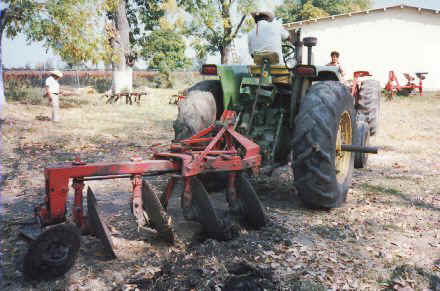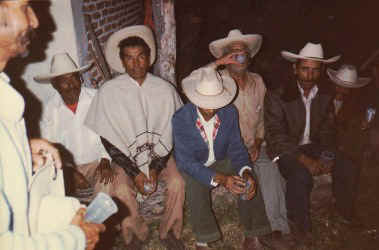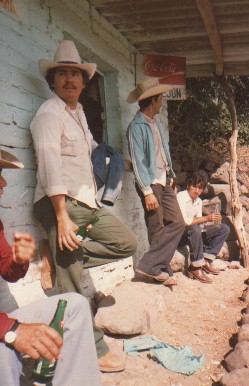Assessing Benefits and Counting Costs
 The Guaracha ejido's second comisariado ejidal, Rafael Vargas (centre), who led the community during the division of the collective ejido into individual plots and had been a migrant in the United States in the 1920s, with his son Salvador (left), who was comisariado ejidal from 1983 to 1986 and ran a campaign against corruption in Banrural, subsequently becoming a local leader of the neocardenista movement and the centre-left PRD. The tractor was provided to a group of ejidatarios under a government credit scheme.
The Guaracha ejido's second comisariado ejidal, Rafael Vargas (centre), who led the community during the division of the collective ejido into individual plots and had been a migrant in the United States in the 1920s, with his son Salvador (left), who was comisariado ejidal from 1983 to 1986 and ran a campaign against corruption in Banrural, subsequently becoming a local leader of the neocardenista movement and the centre-left PRD. The tractor was provided to a group of ejidatarios under a government credit scheme.
Farming an ejidal parcela did at least bring most ejidatarios a substantially better income than working as a labourer in the 1970s and early 1980s. After the 1982 crisis, Mexico, along with other Latin American countries, entered a lost decade in which state support for peasant agriculture was progressively withdrawn. By 1990, peasant producers of sorghum, the most popular crop in the Ciénega at the start of the decade, had seen costs escalate dramatically whilst market prices fell, as a result of the reduction of subsidies and removal of controls on imports: even with yields of 6 tons per hectare, far higher than the Ciénega average, a producer with 3.5 hectares could attain a net income little greater than a single minimum wage at the start of Nineties. By this stage, another of the great benefits of statization from the peasant point of view was also disappearing: the full insurance against crop failure provided by the state agency ANAGSA, which was replaced by a new scheme, supposedly to be run according to strictly commercial criteria and administered by the AGROASEMEX company, in 1990.Although ANAGSA only covered the ejidatario’s debt to the state credit bank, BANRURAL, so that farmers who lost their harvests entirely would be left without any net income, they were at least spared the debts which had previously bound them to the usurers and neolatifundists. Furthermore, officials were often willing and eager to organize fraudulent insurance claims which were generally beneficial to the peasants concerned (though the lion’s share of the proceeds went to the officials). Fraud was endemic to the administration of the statized system, and had a variety of further consequences. A large proportion of the resources directed towards peasant farmers was simply diverted into the pockets of officials or private entrepreneurs renting ejidal land.
 (left) Supporters of Salvador Vargas, including the old agrarista Cleofas Prado (back, left) and the brother of the former adminstrator of the Yepes neolatifundio, one of whose sons, backed by Banrural officials, was a rival candidate, meet to discuss strategy for the ejidal elections.
(left) Supporters of Salvador Vargas, including the old agrarista Cleofas Prado (back, left) and the brother of the former adminstrator of the Yepes neolatifundio, one of whose sons, backed by Banrural officials, was a rival candidate, meet to discuss strategy for the ejidal elections.
Maladministration by BANRURAL officials promoted the development of a "black market" in vital inputs such as fertilizers, which meant that private sector farmers and a small elite within the ejidos themselves were the main beneficiaries of the subsidies offered to the countryside by the government. This situation not only represented a great cost to the rest of society, including urban workers, but also reduced the dynamism of a capitalist agriculture which had less incentive to innovate and maximize efficiency whilst it could continue to feed off the ejido sector.
The pervasiveness of corruption was, however, in part a reflection of the political significance of land reform, and of the way the hegemony of the ruling party, the PRI, had been maintained in rural areas through the support of local and regional bosses whose function was to harvest the votes of ejidatarios. The massive state intervention in the countryside in the 1970s was enormously productive of cacicazgos, as new careers were built on the wealth and power which accrued from managing some of the ambitious new development projects that the government funded, such as an ejidal strawberry processing plant and various schemes for promoting high grade dairy herds in the Ciénega. Even the more humble role of ejidal commissar now became a certain route to personal advancement for those who "cooperated" with higher-level officials. The peasantry of the Ciénega began to refer to themselves as victims of a "mafia" of officials and political promoters whose impunity was often guaranteed by personal networks in the state or national capital.
 An inspector of the parastatal farm insurance agency, the ANAGSA, enjoys a soft drink during an inspection.
An inspector of the parastatal farm insurance agency, the ANAGSA, enjoys a soft drink during an inspection.
Nevertheless, the mere expansion of the state sector of the economy brought other benefits to areas like the Ciénega, in the form of a vast increase in manual as well as professional jobs in the public sector, increasing the number of local sources of income available to households. Many peasant households invested the scarce resources they saved from a combination of farming and labour migration in education, on the assumption that this would provide social mobility for the next generation, and at the end of the 1970s and beginning of the 1980s, such a strategy seemed to be paying off. The onset of crisis with the economic collapse at the end of the López Portillo period and the switch to neoliberal policies under the administration of De la Madrid was soon to dampen such hopes.
Between 1983 and the accession of Salinas to the presidency, jobs in the public sector disappeared at an accelerating rate. The real earnings of local professionals, especially school teachers, dropped sharply, to the point where many of them chose to supplement their incomes by migrating to the United States.
Video Clip - Click on Quicktime Logo
Even after preparing the land was mechanised, cultivation of maize continued to be done with ploughs drawn by mules or horses (troncos) in the rainy season, and some farmers continued to use animals even for preparation if their plots contained large numbers of stones. This ejidatario managed to avoid dependence on Banrural, with the aid of migrant children, working with his plough for other farmers who lacked their own troncos as well as cultivating his own land. In the video clip he is dealing with a new and rather feisty animal.



 The Guaracha ejido's second comisariado ejidal, Rafael Vargas (centre), who led the community during the division of the collective ejido into individual plots and had been a migrant in the United States in the 1920s, with his son Salvador (left), who was comisariado ejidal from 1983 to 1986 and ran a campaign against corruption in Banrural, subsequently becoming a local leader of the neocardenista movement and the centre-left PRD. The tractor was provided to a group of ejidatarios under a government credit scheme.
The Guaracha ejido's second comisariado ejidal, Rafael Vargas (centre), who led the community during the division of the collective ejido into individual plots and had been a migrant in the United States in the 1920s, with his son Salvador (left), who was comisariado ejidal from 1983 to 1986 and ran a campaign against corruption in Banrural, subsequently becoming a local leader of the neocardenista movement and the centre-left PRD. The tractor was provided to a group of ejidatarios under a government credit scheme. (left) Supporters of Salvador Vargas, including the old agrarista Cleofas Prado (back, left) and the brother of the former adminstrator of the Yepes neolatifundio, one of whose sons, backed by Banrural officials, was a rival candidate, meet to discuss strategy for the ejidal elections.
(left) Supporters of Salvador Vargas, including the old agrarista Cleofas Prado (back, left) and the brother of the former adminstrator of the Yepes neolatifundio, one of whose sons, backed by Banrural officials, was a rival candidate, meet to discuss strategy for the ejidal elections. An inspector of the parastatal farm insurance agency, the ANAGSA, enjoys a soft drink during an inspection.
An inspector of the parastatal farm insurance agency, the ANAGSA, enjoys a soft drink during an inspection.